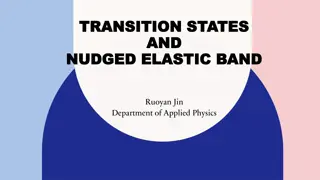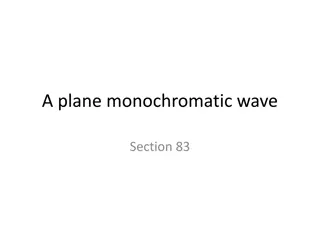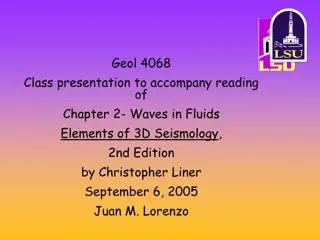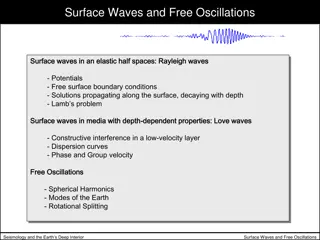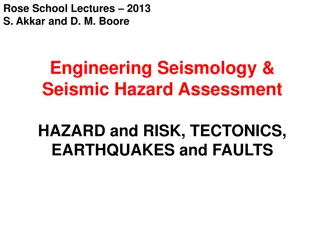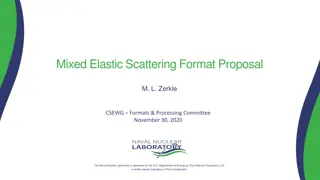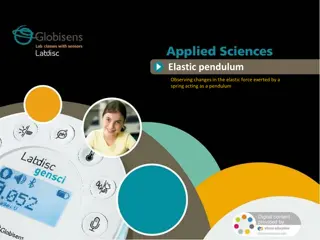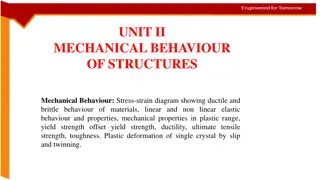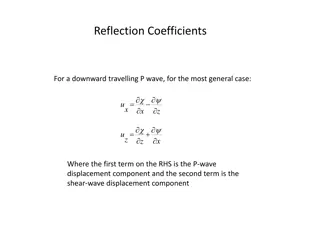Understanding Elastic Wave Equations in Seismology
Explore the fundamentals of elastic wave equations for seismology, including topics such as plane wave propagation, reflection coefficients, and wavefield simplifications using curl and div operators. Learn about P-waves, shear waves, and elastodynamic potentials in the context of infinite homogeneous isotropic media. Gain insights into wave propagation in the Earth's deep interior.
Download Presentation

Please find below an Image/Link to download the presentation.
The content on the website is provided AS IS for your information and personal use only. It may not be sold, licensed, or shared on other websites without obtaining consent from the author. Download presentation by click this link. If you encounter any issues during the download, it is possible that the publisher has removed the file from their server.
E N D
Presentation Transcript
The Elastic Wave Equation Elastic waves in infinite homogeneous isotropic media Numerical simulations for simple sources Plane wave propagation in infinite media Frequency, wavenumber, wavelength Conditions at material discontinuities Snell s Law Reflection coefficients Free surface Seismology and the Earth s Deep Interior The elastic wave equation
Equations of motion 2 = + u f t i i j ij What are the solutions to this equation? At first we look at infinite homogeneous isotropic media, then: = + 2 ij ij ij = + + ( ) u ( u u ij k k ij i j j i ) ) i = + + + 2 ( u f u u u i i j k k ij i j j t = + + + 2 2 u f u u u i i i k k i j j i t j Seismology and the Earth s Deep Interior The elastic wave equation
Equations of motion homogeneous media = + + + 2 2 u f u u u i i i k k i j j i t j We can now simplify this equation using the curl and div operators = i u = = = + + 2 2 x 2 y 2 z iu u - u u and = + ( + 2 ) - u 2 u f u t this holds in any coordinate system This equation can be further simplified, separating the wavefield into curl free and div free parts Seismology and the Earth s Deep Interior The elastic wave equation
Equations of motion P waves = ( + 2 ) - u 2 u u t Let us apply the div operator to this equation, we obtain t = ( + 2 2 ) where u Acoustic wave equation = = iu P wave velocity i or + 2 = 2 2 = t Seismology and the Earth s Deep Interior The elastic wave equation
Equations of motion shear waves = ( + 2 ) - u 2 u u t Let us apply the curl operator to this equation, we obtain ) ( i u t + = = = Wave equation for shear waves + 2 ( ) u i 0 we now make use of and define iu Shear wave velocity to obtain i = 2 2 = t Seismology and the Earth s Deep Interior The elastic wave equation
Elastodynamic Potentials Any vector may be separated into scalar and vector potentials + = u where is the potential for P waves and the potential for shear waves = = = = u P-waves have no rotation Shear waves have no change in volume t = = 2 2 2 2 t Seismology and the Earth s Deep Interior The elastic wave equation
Seismic Velocities Material and Source Water P-wave velocity (m/s) 1500 shear wave velocity (m/s) 0 Loose sand 1800 500 Clay Sandstone 1100-2500 1400-4300 Anhydrite, Gulf Coast 4100 Conglomerate 2400 Limestone 6030 3030 Granite 5640 2870 Granodiorite 4780 3100 Diorite 5780 3060 Basalt 6400 3200 Dunite 8000 4370 Gabbro 6450 3420 Seismology and the Earth s Deep Interior The elastic wave equation
Solutions to the wave equation - general Let us consider a region without sources t = 2 2 c Where could be either dilatation or the vector potential and c is either P- or shear-wave velocity. The general solution to this equation is: = ( , ) ( ) x t G a x ct i j j Let us take a look at a 1-D example Seismology and the Earth s Deep Interior The elastic wave equation
Solutions to the wave equation - harmonic Let us consider a region without sources t = 2 2 c The most appropriate choice for G is of course the use of harmonic functions: = ( , ) exp[ ( )] u x t A ik a x ct i i i j j Seismology and the Earth s Deep Interior The elastic wave equation
Solutions to the wave equation - harmonic taking only the real part and considering only 1D we obtain = ( , ) cos[ ( )] u x t A k x ct 2 2 2 = = = ( ) k x ct kx kct x t x t T c k wave speed wavenumber wavelength T period frequency A amplitude Seismology and the Earth s Deep Interior The elastic wave equation
Spherical Waves Let us assume that is a function of the distance from the source t = 2 2 c 2 1 r = r + r = 2 2 t 2 r c where we used the definition of the Laplace operator in spherical coordinates let us define = r to obtain = t = 2 2 ( ) f r t c with the known solution Seismology and the Earth s Deep Interior The elastic wave equation
Geometrical spreading so a disturbance propagating away with spherical wavefronts decays like 1 1 = ( ) f r t r r r ... this is the geometrical spreading for spherical waves, the amplitude decays proportional to 1/r. If we had looked at cylindrical waves the result would have been that the waves decay as (e.g. surface waves) 1 r Seismology and the Earth s Deep Interior The elastic wave equation
Plane waves ... what can we say about the direction of displacement, the polarization of seismic waves? + = u = P S = + u P S = ... we now assume that the potentials have the well known form of plane harmonic waves ) ( exp t i A = x k = k x B exp ( ) i t = = k k x P exp ( ) k B k x S A i t exp ( ) i t shear waves are transverse because S is normal to the wave vector k P waves are longitudinal as P is parallel to k Seismology and the Earth s Deep Interior The elastic wave equation
Heterogeneities .. What happens if we have heterogeneities ? Depending on the kind of reflection part or all of the signal is reflected or transmitted. What happens at a free surface? Can a P wave be converted in an S wave or vice versa? How big are the amplitudes of the reflected waves? Seismology and the Earth s Deep Interior The elastic wave equation
Boundary Conditions ... what happens when the material parameters change? 1v1 welded interface 2v2 At a material interface we require continuity of displacement and traction A special case is the free surface condition, where the surface tractions are zero. Seismology and the Earth s Deep Interior The elastic wave equation
Reflection and Transmission Snells Law What happens at a (flat) material discontinuity? sin i v = 1 1 Medium 1: v1 i1 sin i v 2 2 i2 Medium 2: v2 But how much is reflected, how much transmitted? Seismology and the Earth s Deep Interior The elastic wave equation
Reflection and Transmission coefficients Let s take the most simple example: P-waves with normal incidence on a material interface R A 1 R = 2 2 1 + 1 Medium 1: r1,v1 A 2 2 1 Medium 2: r2,v2 1 + 2 T = 1 1 A T 2 2 1 At oblique angles conversions from S-P, P-S have to be considered. Seismology and the Earth s Deep Interior The elastic wave equation
Reflection and Transmission Ansatz How can we calculate the amount of energy that is transmitted or reflected at a material discontinuity? We know that in homogeneous media the displacement can be described by the corresponding potentials + = u in 2-D this yields u = = x x y z u y z x x z = + u z z x y an incoming P wave has the form = exp ( ) A i a x t 0 j j Seismology and the Earth s Deep Interior The elastic wave equation
Reflection and Transmission Ansatz ... here ai are the components of the vector normal to the wavefront : ai=(cos e, 0, -sin e), where e is the angle between surface and ray direction, so that for the free surface = + + exp ( tan ) exp ( tan ) A ik x x e ct A ik x x e ct 0 1 3 1 3 = + exp ( ' tan ' ) B ik x x f c t 1 3 f e cos = = where c ' c Pr e cos f = = cos k e = ' cos k f c SVr P = 0 what we know is that xz = 0 zz Seismology and the Earth s Deep Interior The elastic wave equation
Reflection and Transmission Coefficients ... putting the equations for the potentials (displacements) into these equations leads to a relation between incident and reflected (transmitted) amplitudes 2 2 4 tan tan 1 ( tan ) A e f f = = R PP + 2 2 4 tan tan 1 ( tan ) A e f f 0 2 4 tan e 1 ( + tan ) B e f = = R PS 2 2 4 tan tan 1 ( tan ) A f f 0 These are the reflection coefficients for a plane P wave incident on a free surface, and reflected P and SV waves. Seismology and the Earth s Deep Interior The elastic wave equation
Case 1: Reflections at a free surface A P wave is incident at the free surface ... i j P P SV The reflected amplitudes can be described by the scattering matrix S = P P P S P u d u d S S S S u d u d Seismology and the Earth s Deep Interior The elastic wave equation
Case 2: SH waves For layered media SH waves are completely decoupled from P and SV waves SH There is no conversion only SH waves are reflected or transmitted S S S S u d u d = S S S S S u d u d Seismology and the Earth s Deep Interior The elastic wave equation
SH example Seismology and the Earth s Deep Interior The elastic wave equation
SH relation cos( ) cos( ) = 1 1 1 2 2 2 S S d u + cos( ) cos( ) 1 1 1 2 2 2 2 cos( + ) = 1 1 1 S S d d cos( ) cos( ) 1 1 1 2 2 2 Seismology and the Earth s Deep Interior The elastic wave equation
Polarity effects Seismology and the Earth s Deep Interior The elastic wave equation
Example for crust SH case Seismology and the Earth s Deep Interior The elastic wave equation
Case 3: Solid-solid interface SVr Pr P SVt Pt To account for all possible reflections and transmissions we need 16 coefficients, described by a 4x4 scattering matrix. Seismology and the Earth s Deep Interior The elastic wave equation
Case 4: Solid-Fluid interface SVr Pr P Pt At a solid-fluid interface there is no conversion to SV in the lower medium. Seismology and the Earth s Deep Interior The elastic wave equation
Reflection coefficients - example Seismology and the Earth s Deep Interior The elastic wave equation
Reflection coefficients - example Seismology and the Earth s Deep Interior The elastic wave equation
Summary In homogeneous full space P and S waves are solutions to the elastic wave equation P waves are compressional (curl-free) and S waves are transversal (div-free) Material discontinuities (stress continuity) leads to transmission and reflection coefficients and conversions for each wave type Information from reflected waves can be used to inver the change of material properties AVO amplitude versus offset AVA amplitude versus angle Seismology and the Earth s Deep Interior The elastic wave equation







